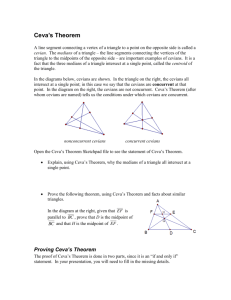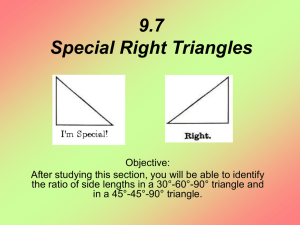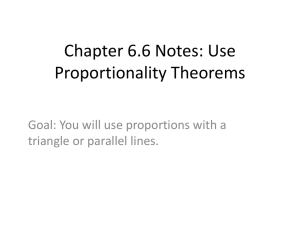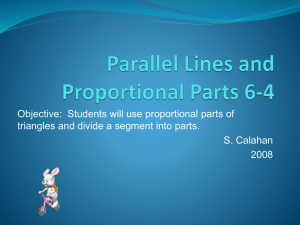Geometry Problems and Solutions: Ceva's, Desargues' Theorems
advertisement
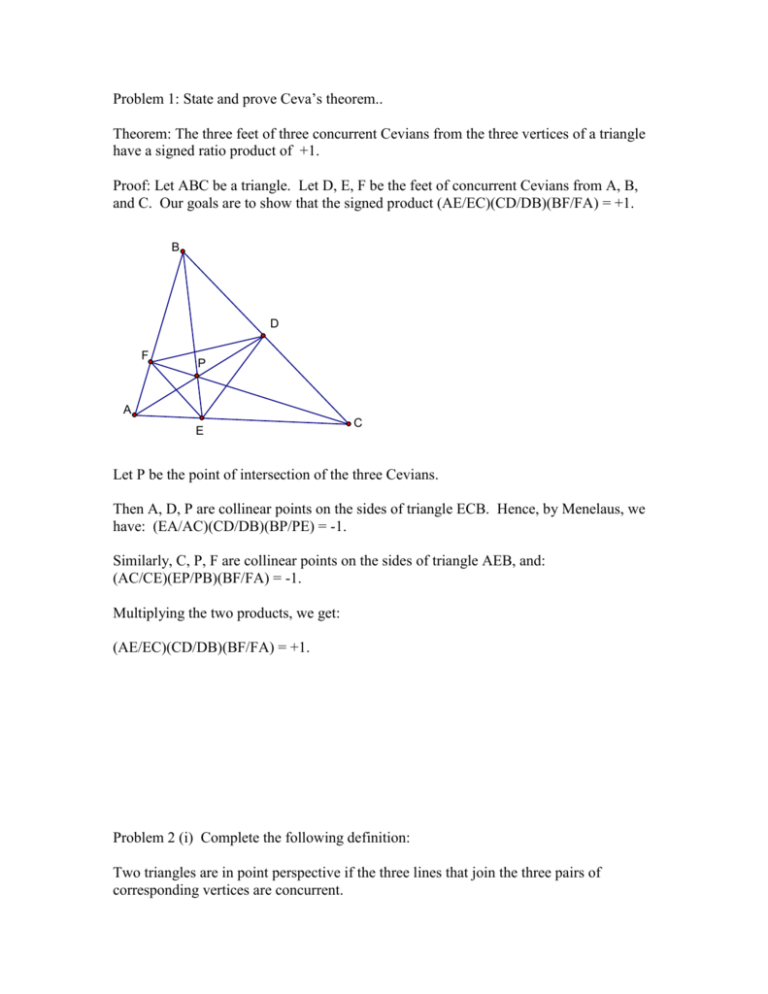
Problem 1: State and prove Ceva’s theorem.. Theorem: The three feet of three concurrent Cevians from the three vertices of a triangle have a signed ratio product of +1. Proof: Let ABC be a triangle. Let D, E, F be the feet of concurrent Cevians from A, B, and C. Our goals are to show that the signed product (AE/EC)(CD/DB)(BF/FA) = +1. B D F P A E C Let P be the point of intersection of the three Cevians. Then A, D, P are collinear points on the sides of triangle ECB. Hence, by Menelaus, we have: (EA/AC)(CD/DB)(BP/PE) = -1. Similarly, C, P, F are collinear points on the sides of triangle AEB, and: (AC/CE)(EP/PB)(BF/FA) = -1. Multiplying the two products, we get: (AE/EC)(CD/DB)(BF/FA) = +1. Problem 2 (i) Complete the following definition: Two triangles are in point perspective if the three lines that join the three pairs of corresponding vertices are concurrent. (ii) Complete the following definition: Two triangles are in line perspective if the three points of intersection of corresponding edges are collinear. (iii) State and prove the converse of Desargues theorem. (You may use Desargues theorem, but you must explain exactly why it applies and which are the points involved in its conclusion.) Theorem: If two triangles are in line perspective then they are in point perspective. Proof. Let ABC and A’B’C’ be two triangles that are in line perspective. Write X, Y, and Z for the three collinear points of intersection of opposite sides (with X on BC, Y on CA and Z on AB). Let BB’ and AA’ meet at O. Our goal is to prove that CC’ also passes through O (so that O is a center of perspective). Z B' Y B C' C O A X A' Observe that the triangles XBB’ and YAA’ are in point perspective (centered at Z). According to Desargues Theorem, these triangles are in line perspective. But the points of intersection of their corresponding sides are O (intersection of BB’ and AA’), C (intersection of BX and AY) and C’ (intersection of B’X’ and A’Y”). Hence, the points O, C, C’ are collinear. Problem 3 State and prove the intersecting chord theorem. Theorem: If two chords of a circle intersect, then the product of the two segments cut from one is equal to the product of the two segements cut from the other. Proof: Let AB and CD be two chords of a circle that meet at P. Our goal is to show that AP.BP = CP.DP. Join AD and CB. C A P D B The triangles ADP and CBP are similar (AA: the angles at P are vertically opposite, and the angles at A and C are in the same segment). In particular, AP/CP = DP/BP. We deduce that AP.BP = CP.DP. Problem 4: Suppose that a triangle ABC has three concurrent Cevians AD, BE, and CF and that X, Y, and Z are three points on the sides BC, CA, and AB such that D, E, F, X, Y, and Z all lie on a circle. Prove that the Cevians AX, BY, and CZ are concurrent. Solution: A Y F E Z C B X D According to the intersecting secant theorem, we have BX. BD = BZ. BF Hence: BD/FB = BZ / XB. Similarly, CE/DC = CX/YC and AF/EA = AY/ZA. We deduce that the signed ratio product: (AY/YC)(CX/XB)(BZ/ZA) is equal to the signed product (AF/FB)(BD/DC)(CE/EA). But this second product is +1, by Ceva’s theorem. Hence, the first product is +1, and the Cevians AX, BY, and CZ are concurrent (by the converse of Ceva’s theorem). Problem 5: Suppose that a triangle ABCD is a quadrilateral and that the points P, Q, and R are obtained as the intersections of AD and BC, AB and DC, and AC and BD, respectively. Let T be the intersection of PR and AB. Prove that (AT/TB)(BQ/QA) = -1. Solution: P D C R Q A T B In the triangle ABP, the Cevians AC, BD and PT are concurrent. According to Ceva’s theorem, we have: (AT/TB)(BC/CP)(PD/DA) = +1. Moreover, the points Q, C, D are collinear points on the sides of the same triangle. By Menelaus, we have: (AQ/QB)(BC/CP)(PD/DA) = -1. Dividing these relationships, we obtain (AT/TB)(BQ/QA) = -1. Problem 6: Suppose that a triangle ABC has three Cevians AD, BE, and CF that are concurrent at the point P. Prove that: AP/PD = AF/FB + AE/EC. Solution: Let P be the point of intersection of the three Cevians. B D F P A E C Apply Ceva for the three concurrent Cevians AD, BE, CF. We obtain: (AF/FB)(BD/DC)(CE/EA) = +1. Hence: AE/EC = (AF/FB)(BD/DC). Apply Menelaus to the three collinear points C, P, F on the three sides of triangle ABD: (AP/PD) (DC/CB)(BF/FA) = -1. Therefore: AP/PD = - (AF/FB)(BC/CD). However: BC/CD = - (BD/DC + DC/DC) = -(1 + BD/DC). Thus AP/PD = -(AF/FB). – ( 1 + BD/DC) = AF/FB + (AF/FB)(BD/DC) = AF/FB + AE/EC.


